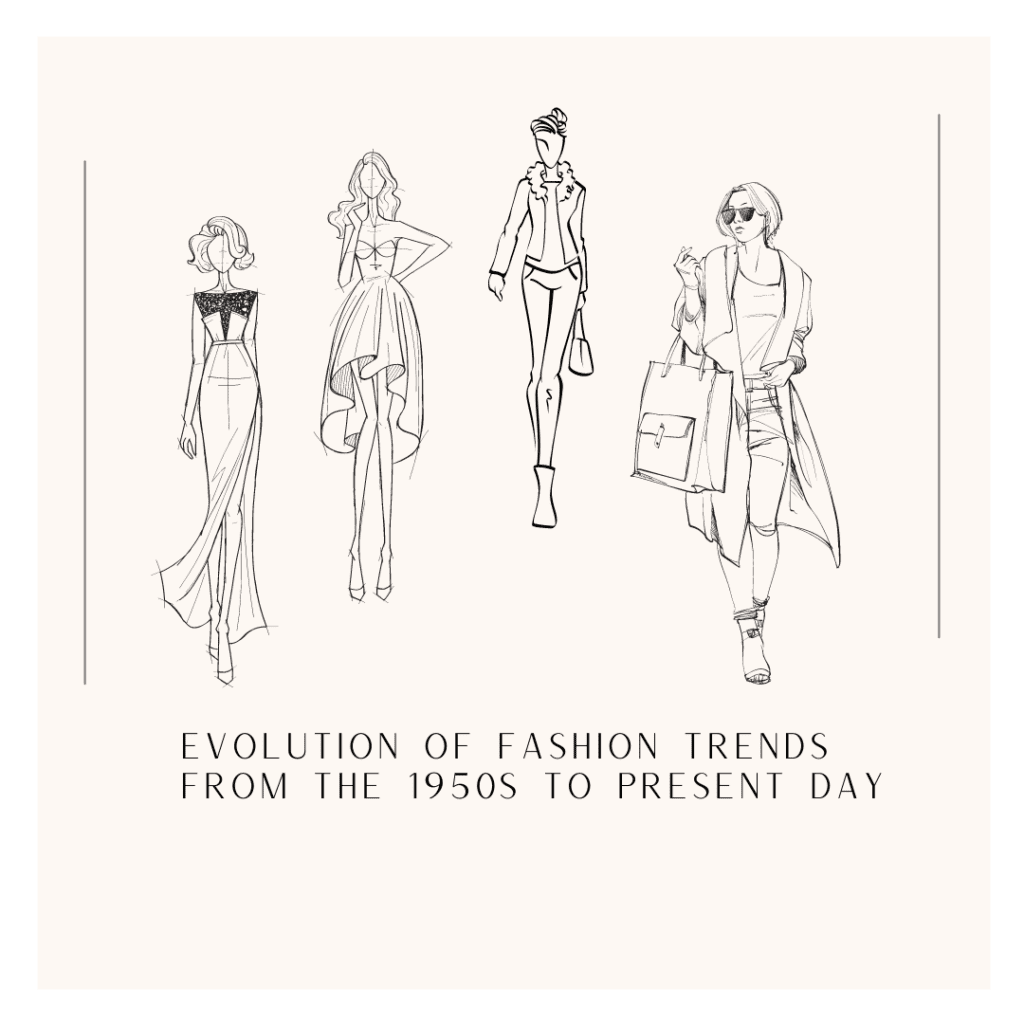Fashion trends emerged from the Industrial Revolution through the development of factories that could rapidly create clothing. This mass production allowed brands to ramp up their output and maximize profits by making new clothing quickly. In addition, the shift from making clothes as a necessity to buying clothes based on style made fashion fun. It also made ready-to-wear options available in department stores that advertised the need for new looks every season. As a result, the constantly changing trends have distinctively marked each decade in fashion.
1950’s Trends
1950’s fashion was casual yet formal and elegant. Shoulder lines became more softened, corset waists became smaller, and rounded hips with long skirts became popular. The iconic gray felt poodle skirts emerged with white bobby socks and saddle shoes. All the while, boys launched the youth culture during the ’50s by dressing casually like the working class. The James Dean uniform of a red jacket, white t-shirt and jeans were also avidly copied during this time.
1960’s Trends
Hippie culture influenced fashion through bold florals, crochet, tie-dye, bell-bottoms, go-go boots, and mini skirts. Bikinis grew in popularity from the rising rebellion of the Women’s Liberation Movement. Women started to express themselves more than ever before and began wearing pants more regularly. The fit and flare dress also became a staple silhouette for going out. Additional trends during the 60’s include turtlenecks, which were popularized by celebrities like Johnny Carson, Steve McQueen and Paul Newman. Black turtlenecks specifically became an iconic statement for the Black Panther Party.
1970’s Trends
The ’70s continued to see the presence of bell-bottoms and tie-dye clothing, but platform boots and shoes became a massive hit. In addition, everyone wanted to be taller. All the while, high-waisted jeans and feathered hair became the norm. Corduroy became popular and round sunglasses, made infamous by John Lennon, circulated within the fashion scene. Military/safari looks emerged through khakis, green rucksacks, camouflage jackets, belts, and boots. Meanwhile, punk enthusiasts rocked black leather jackets, studs and messy hair. Additional trends in the ’70s included wearing hot pants, the chevron pattern, large collars accessorized by necklaces, and the use of love beads, mood rings, and puka shells.
1980’s Trends
Fashion during the ’80s was marked by saturated colours, perms and extravagant silhouettes. Puffed shoulders, flashy skirts, power suits and spandex leggings were the norm. Leg warmers, velour, and parachute pants were also highly worn. Eclecticism dominated the fashion scene, and the punk rock aesthetic of leather, tight trousers, and lace developed and evolved during this time. Political fashion was also common with shirts circulating with slogans like “Choose Life.” In the business world, career-driven women wore tailored power suits with big, padded shoulders with exaggerated silhouettes while more prominent and brighter styles emerged. The street’s predominant “anything goes” attitude was marked by brightly coloured and shiny hoop earrings, bracelets, and necklaces.
1990’s Trends
The ’90s was an era where icons were embodied through clothing. Madonna’s looks included wearing satin bustier tops, ripped jeans and heeled shoes. Julia Roberts’ Pretty Woman look was copied through menswear shirts, high-waisted culottes and court shoes. Trends during the time also included wearing Skidz pants, Air Jordans, tapered jeans, baseball caps, and mullets. Grunge fashion also emerged through flannel shirts, hole-ridden jeans and Doc Martens. Key trendy accessory pieces included the use of chokers, hoop earrings, and scrunchies.
2000’s Trends
2000’s fashion screams Juicy Couture tracksuits, True Religion jeans, The Chloe Paddington bags, low risers, bedazzled bottoms and ribbed tank tops. Dresses over jeans were a distinct combo look, as well as skinny scarves, wide and flashy belts, pocketless jeans, von dutch hats, tank tops over other shirts and tube tops. Uggs were favoured alongside chunky necklaces, Livestrong bracelets, Pashminas, and skull scarves. Boho vibes through the use of flowy maxi skirts and ruffle details were also common.
2010’s Trends
Fashion during this time was covered in different shades of millennial pink. Out on the streets, sneaker wedges and skinny jeans dominated. They were accessorized with fanny packs, merch shirts and fringe details. High-stretch and pocket-less leggings also emerged and were worn for all sorts of different social occasions. Loafers with fur and ankle boots were stapled footwear options, while deconstructed denim was commonly worn as well. Key accessories during this time included headbands, novelty handbags, and floppy hats.
Present Day Trends
The pandemic changed the course of fashion for many—increased time at home created more demand for sweatpants and comfy clothing. Pops of colour emerged through the rise and comeback of tie-dye. Sweatsuits became popular for online and home events, while biker shorts and chunky orthopedic shoes became a go-to option. Crocs were normalized, and cashmere pieces became embraced for their cozy, comfy touch. All the while, Zoom tops were prioritized, and their necklines became a focal point. This made Peter Pan collars, square necklines and turtlenecks a go-to option. Major themes in fashion have now moved towards 90’s nostalgia, cottagecore and cabincore.
The evolution of fashion trends over the last eighty years is a long and complex picture of the everyday life of people. Feel free to explore and wear these trends by visiting second-hand stores and trying out new styles. It can help you move away from current trends and create a unique closet. However, you should also take a moment to reflect on these past trends and understand how you can engage with trends in the future. This can allow you to buy clothing you’ll love for years despite continual changes and options in fashion.

